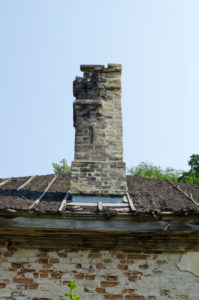While water in the fireplace can be easily cleaned up, it should never be ignored. Chimney leaks, even minor ones, can cause serious damage throughout your fireplace system.
Signs of a Chimney Leak
While chimney leaks are often discovered by the presence of water in the firebox, there are a number of other signs that water entry may be affecting your chimney. The following are just a few of the signs of a chimney leak.
- Moisture, dampness, or water in the firebox
- Rust on the damper
- Masonry spalling
- Sounds of dripping inside the chimney
What Causes a Chimney Leak?
Because chimneys are complex structures there are a number of ways that water can get into the chimney system. The following are three of the most common areas where water can enter your chimney.
- Chimney cap. A chimney cap is a metal top with mesh sides that protects the top of the flue from animal, debris, and water entry. A damaged, sized or incorrectly installed chimney cap allows water into the unprotected chimney.
- Chimney crown. Made of stone or cement, the chimney crown is a slab that covers and seals the top of the chimney. Because of their location, chimney crowns are prone to overexposure to the elements; chips and cracks from repeated exposure can create chimney leaks.
- Chimney flashing. Flashing is when metal strips and other waterproofing materials are layered on the joint between the roofline and the chimney. This watertight seal can be damaged by weather, overexposure, improper installation, or even roof repairs. Leaky flashing can damage not just the chimney, but also nearby walls, ceilings, and building materials.
Repairing a Leaky Chimney
Before repairing a leaky chimney, the source of the water entry must be identified. Identifying and repairing the source of a leak before repairing the damage ensures that the leak will not return in the future. A chimney inspection is often the best way to identify the source of a leak as well as evaluate the damage a leak has caused.
Once the source of the leak has been identified, the damaged caused by the leak can be repaired; repairing a leaky chimney as soon as possible prevents serious masonry or structural damage from occurring. There are a few of the ways your chimney can be repaired after a chimney leak. One option is to replace damaged bricks and mortar through tuckpointing. Another option is to install a new chimney cap.
Preventing Future Chimney Leaks
One way to protect your chimney against future leaks is by having the masonry waterproofed. In the waterproofing process, a water repellent specifically designed for masonry is applied to the bricks and mortar of your chimney. Our SaverSystems products help prevent leaks by repelling water from the masonry and can used to stop additional water damage from occurring.
A leaky chimney is more than just a minor inconvenience. You should repair leaks as soon as possible to prevent dangerous chimney damage from occurring. For more information on preventing or repairing chimney leaks, contact Jack Pixley Sweeps today.
 There are a number of ways we get our fireplaces ready for winter; having them swept, buying new firewood, and sweeping out ashes and coals are all ways to make sure your fireplace is safe and ready to use. However, there may be hidden hazards hiding in your chimney liner.
There are a number of ways we get our fireplaces ready for winter; having them swept, buying new firewood, and sweeping out ashes and coals are all ways to make sure your fireplace is safe and ready to use. However, there may be hidden hazards hiding in your chimney liner.
A properly lined chimney is an important part of the helping your fireplace burn safely, efficiently, and last longer. Because the majority of the chimney liner cannot be seen without an inspection and the use of technology such as closed circuit cameras, damage to the chimney liner may go unnoticed.
How a chimney liner protects your home
According to the Chimney Safety Institute of America, chimney liners are “A clay, ceramic, or metal conduit installed inside of a chimney, intended to contain the combustion products, direct them to the outside atmosphere, and protect the chimney walls from heat and corrosion.”
Because of their important purpose, a requirement for chimney liners is included in most state and local building codes. Chimney liners play an important role in protecting your home against the heat, gas, and smoke created in your fireplace. Protecting against a transfer of heat keeps surrounding walls, beams, frames, and other building materials from reacting to the heat in the chimney; when a chimney liner is damaged, the National Bureau of Standards found adjacent building materials can catch fire in as little as three hours due to heat transfer.
Chimney liners also keep smoke and gasses from getting into the air supply of your home. A quality, undamaged liner helps keep toxic byproducts of combustion, including the extremely dangerous carbon monoxide gas venting safely up and out of your chimney instead of lingering in the flue or seeping into your home. This is especially important during the winter when most homes have their doors and windows tightly closed, letting in little outside air.
Does my chimney need to be relined?
Because of the difficult to access location, length, and size of the chimney liner, repairs in specific areas are often too difficult to complete. Because of this, a complete chimney relining may be recommended. There are several reasons why a chimney might need to be relined.
Damage. Damage to the chimney liner can cause it to lose the ability to protect your home against heat transfer, as well as allow smoke and gas into your home’s air supply.
New fireplace or insert. A new fireplace or insert may have different venting requirements than your old unit; relining the flue can ensure your new fireplace burns as safely and efficiently as possible.
Changing fuel sources. The byproducts of combustion from wood, gas, coal, and pellet fires are all different; because of this, they require different types of chimney liners. If you have changed fuel sources, a new chimney liner can protect your flue.
Winter weather is just around the corner; make sure your fireplace is ready to be safely used all year round by having the liner checked. For more information on the importance of a quality chimney liner or to have your chimney inspected, contact Jack Pixley Sweeps today!

By ensuring proper care and maintenance for your chimney, you are adding more years to its life and increasing its functionality.
In chimneys as in life, it’s always worth thinking and talking about the future, and making sure you’re doing everything you can to ensure health, longevity and happiness. Your chimney is an important part of your home — it’s working hard, every time you have a fire, to carry dangerous gases and byproducts up and out of your living area, and protecting the building materials around your fireplace or stove from the high heat produced by that fire. A chimney can also be an expensive thing to tear down and rebuild, so focusing energy on protecting and preserving it is always a good call.
Wondering what you can and should do to extend the life of your chimney? Jack Pixley Sweeps techs are always glad to help our clients avoid headaches and get the most enjoyment possible out of their heating system.
Don’t Skimp On Regular Maintenance
We say it all the time: The best thing you can do for your chimney system (and your long-term and short-term enjoyment of it) is to diligently keep up with regular maintenance.
Annual chimney inspections are important — not only are Jack Pixley technicians able to make sure that your system is venting properly and doing its job effectively, but we’re also able to catch small problems early and make the proper repairs, before those small problems become large, potentially destructive issues.
Regular chimney sweeping is just as important. Creosote and other deposits build up in your flue as you use your appliance, and a dirty chimney can lead to a mix of short-term and long-term problems. Heavy creosote can block your flue and inhibit your chimney’s ability to vent, allowing dangerous gases to enter your living area. It can also lead to a chimney fire that severely damages your flue liner, even your chimney (or in the worst cases, your home) itself. Acidic deposits can also wear at your flue liner over time, leading to worn joints, cracks and gaps.
One of the key things we’ve learned over more than three decades of servicing chimneys in the greater Twin City area: Keeping up with those regular maintenance appointments will make a big difference in the longevity of your chimney.
Be Diligent About Moisture Intrusion
Your chimney system was designed with built-in protection against water intrusion. Your chimney crown is there to divert rain and snow away from the flue. Your flashing is there to keep water from getting into the joints where your chimney and roofline meet. Your chimney cap is there, in part, to help protect your flue opening from moisture intrusion too. Keeping an eye on all of those key areas of protection is worthwhile.
Jack Pixley technicians will always check those components during your annual chimney inspection, but in between inspections, if you notice an issue — a chimney cap that’s come off in a storm, or a part of your flashing that’s pulled up — give us a call. Repairing those issues quickly is important, since chimney leaks can quickly lead to considerable damage.
If you want to be particularly proactive in protecting your chimney system against moisture intrusion and damage, we recommend having us apply masonry water repellant, which helps your masonry deflect water and can significantly lengthen its service life.
Use Smart Burning Practices
A really important thing to always keep in mind: The right fuel for your wood-burning fireplace or stove is seasoned or kiln-dried cordwood, and only that. Burning green or moist wood can create immediate and long-term problems, from increased smoke and staining now to the development of dangerous Third Stage Creosote down the line (which is extremely combustible and extremely difficult to remove). Burning trash, treated wood or plastics can allow toxic gases into your living area, too.
Stick to the right fuel, and it’ll help you enjoy your fires now, and keep your chimney healthier in the long run.
Do you have any questions about how to best care for your chimney system? We’re always glad to help. Give Jack Pixley Sweeps a call!

Watch out for the signs of chimney damage. Have it inspected and repaired right away!
Now that spring is headed our way, we can finally cut back on using your chimney. This is also the time you need to start thinking about maintenance. You should have at least one chimney sweep and inspection done every year. You can find the right technician by not only reading reviews and trusting in your family and friends, but also making sure that they are Chimney Safety Institute of America (CSIA) certified. To schedule your chimney appointment, call the pros at Jack Pixley Sweeps.
What kind of repairs will need to be done to your chimney?
Even the smallest crack can turn into the biggest hassle if not dealt with. This is why if you see something out of the ordinary that you call for a checkup. If you live in an area where high precipitation is common, then any crack you have in the structure could hold this water and allow mold to grow. This can happen in as little as two days, and the mold can spread to the foundation of your home and you air supply.
Water can also enter the chimney when the flashing is damaged. Sometimes the flashing can be repaired, but often it will just need replacing. Lastly, a chimney cap will keep water from running down inside of the chimney and causing liner and other internal damage.
After these repairs are finished, your technician may suggest waterproofing your chimney. This is a simple process in which a sealant is sprayed on the chimney to help prevent water damage. You should always make sure you are sealing a dry, clean chimney.
What happens when these repairs are not taken care of?
When repairs are left for long periods of time without care, they can worsen. Cracks will begin to expand and will be able to collect more water after more storms and high winds. Also, if you do not have your chimney sweep on time, blockages can become larger and more dangerous. This could lead to a higher chance of chimney fire. Blockages will cause draft problems as well, which could keep harmful gases like carbon monoxide in.

Chimney care should be a must on your to-do list for Spring. It deserves to be given proper attention after enduring the cold winter days while keeping you warm.
Spring. It’s the time of the year where you can free yourself from months of wearing thick clothes and triple socks. It’s the perfect time to finally go outside and play without having to worry about freezing to death. It’s also the time where your chimney can finally rest and prepare for the next time of extensive usage. But it doesn’t mean that you’ll just tuck away your chimney until the next winter. No, there are still some things to take care of because of the shift in temperature.
Chimney Inspection and Sweeping
Here at Jack Pixley Sweeps & Masonry we’d like to present a Spring checklist so that when one of our certified CSIA chimney sweeps knock on your door, you already know what to expect. The very first and very basic things to do are the routine inspection and sweeping. From there they can assess whether or not your chimney needs any of the following:
Waterproofing
As winter comes to an end, there will be a lot of traces of melting snow. This is bad for the chimney because huge volumes of water can destroy the chimney. The chimney will start to degrade overtime and water can enter the small cracks and joints of the masonry brick walls that will further speed up the degradation of the chimney. When this happens, there might be a need for waterproofing. When we’re done, even the smallest ant cannot find cracks to live in inside your chimney. Another good way to keep water out is to install chimney flashing. This will block water from coming in where the exterior of the chimney meets the roof.
Chimney Relining
Again, as the chimney gets old, damage to the the flue and the flue liner will be inevitable. This problem should be addressed right away because it leads to poor chimney draft. If there are holes in the flue, there won’t be enough pressure to push up all the smoke to the chimney and you’ll have a smoky fireplace. If the flue liner is the problem, chimney relining will solve it. Otherwise, if the damage is to the structure of the flue itself, we might have to go as far as replacing the whole thing.
Install a Chimney Cap
Since we’re talking about spring, there are now bigger opportunities for debris, leaves and other obstructions (including tiny animals looking for a home) to enter the chimney. Having a chimney cap installed will totally stop these things from entering the inside of the chimney.
These are a few of the things that we can to do ensure that your chimney will last for many years to come. And not only that, when you invest in maintaining your chimney, you won’t have to worry about accidents due to functional problems while using your chimney. You’ll also end up saving money in the long run by avoiding these untoward incidents that might cause severe damage to your property. Make an appointment with us now. Jack Pixley Chimney Sweeps & Masonry: “It’s the name you can trust.”

 There are a number of ways we get our fireplaces ready for winter; having them swept, buying new firewood, and sweeping out ashes and coals are all ways to make sure your fireplace is safe and ready to use. However, there may be hidden hazards hiding in your chimney liner.
There are a number of ways we get our fireplaces ready for winter; having them swept, buying new firewood, and sweeping out ashes and coals are all ways to make sure your fireplace is safe and ready to use. However, there may be hidden hazards hiding in your chimney liner.

